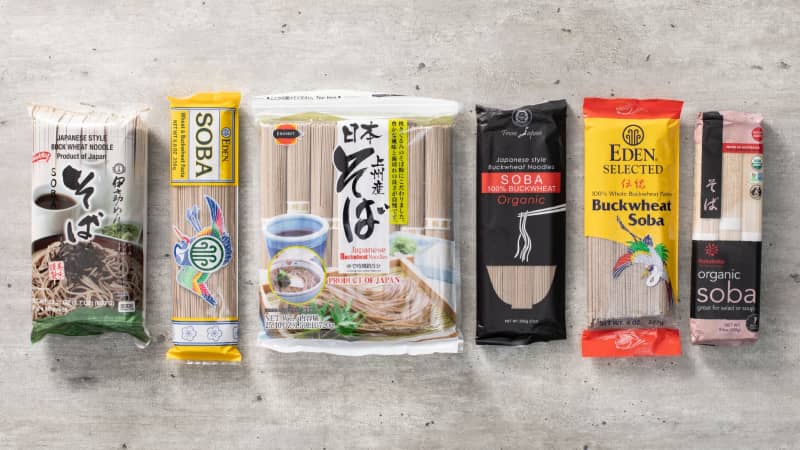The Best Soy Sauce
Taste Test
These delicate buckwheat strands are one of Japan's most popular foods. We tasted six products to see how they differed.
Published July 19, 2019. Appears in America's Test Kitchen TV Season 21: Japanese-Inspired Favorites

Soba noodles have been an important part of Japanese cuisine since they were first developed in the country in the late 1500s or early 1600s. It's traditional to eat soba on New Year's Eve and to gift soba to new neighbors because, among other things, the long, slim noodles are thought to bring good luck and a long life. But they're not just for special occasions. Japan has tens of thousands of soba shops—from elegant, formal restaurants to casual spots. You can even buy soba noodles from vending machines. It's easy to see why these buckwheat noodles are so popular: They're hearty and slightly chewy, with a delicate earthy, nutty flavor. In the summertime, soba noodles are refreshing when served chilled with a dipping sauce or cold broth. And in colder weather, these noodles form the foundation for comforting, satisfying hot soups. We love them both in time-honored Japanese recipes and in some nontraditional applications, such as soba noodle salads.
Dried soba noodles are easy to find in Asian markets, in many grocery stores, and online. Which ones should you buy? To find out, we purchased six kinds of dried soba noodles, priced from about $3 to about $9 per package, and sampled them in two blind tastings. First, we ate them plain, sampling them with a side of traditional tsuyu, a Japanese dipping sauce made by combining dashi and a soy sauce, mirin, and sugar mixture called kaeshi. Next, we sampled them in a salad with vegetables.
Traditional dried soba noodles have just two ingredients: buckwheat flour and water. Buckwheat flour contains no gluten, the protein that gives wheat-based doughs their elasticity. As a result, doughs made with buckwheat flour are delicate and the noodles tend to be more fragile than noodles that contain a blend of buckwheat flour and wheat flour. Two of the noodles in our lineup were made from 100 percent buckwheat flour, while four were made from a blend of buckwheat and wheat flours.
Let's cut to the chase. The presence of wheat flour changes both the flavor and the texture of the noodles. While we liked every product we tasted, they were very different. The noodles made from buckwheat flour tasted deeply earthy, nutty, and faintly sweet. That big buckwheat flavor stood out even when the noodles were tossed with a bold dressing and vegetables in a salad or dipped in tsuyu. Tasters liked that the “toasty buckwheat flavor” was “pronounced” and “came through with each bite.”
Conversely, noodles made from a blend of buckwheat and wheat flours tasted milder because the addition of wheat flour tempered the buckwheat's intensity. The exact ratio of flours isn't typ...
The mission of America’s Test Kitchen Reviews is to find the best equipment and ingredients for the home cook through rigorous, hands-on testing.

Kate is a deputy editor for ATK Reviews. She's a culinary school graduate and former line cook and cheesemonger.

This is a members' feature.